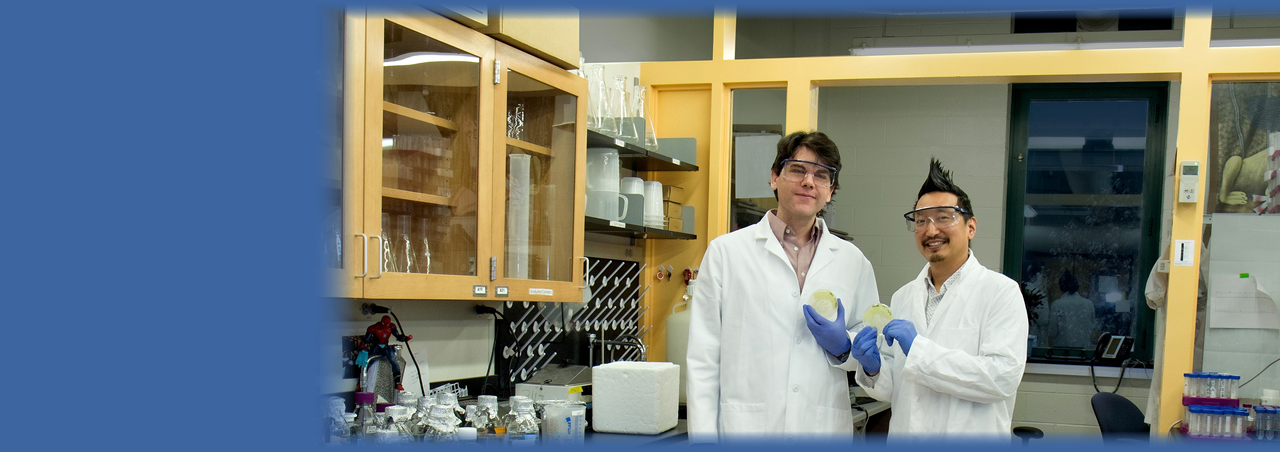Teaming up to target antibiotic resistance
Antibiotic resistance is an accelerating threat to human health worldwide—but one that researchers from neighboring SUNY campuses are combining their skills to address. Drawing on bioengineering expertise from the College of Environmental Science and Forestry (ESF) and infectious disease testing at Upstate Medical University, the duo introduced a completely new approach to antibiotic development.
“They have the experience and background to work with host-pathogen disease models at SUNY Upstate, which is why they're a great partner for us,” says Christopher Nomura, a professor of chemistry and vice president for research at ESF.
“It definitely helps that we're in close proximity, it takes me maybe 10 minutes to walk up the street,” adds Megan Gribble Lloyd G’17, who began working on this project as a Ph.D. student in the lab of Jennifer Moffat, associate professor of microbiology and immunology.
Nomura and Lloyd’s work, which resulted in one publication in Scientific Reports so far, focuses on the bacterium Pseudomonas aeruginosa. While not a major threat to healthy individuals, the bacteria causes long lasting, but often ultimately deadly, infections in cystic fibrosis patients and others with compromised immune systems.
In recognition of P. aeruginosa’s ability to evade current antibiotics, the World Health Organization named it one of 12 “priority pathogens” demanding more research.
“You throw more antibiotics or new antibiotics at Pseudomonas infections and over time it becomes this war between the bacteria and the antibiotics,” Lloyd says. “Unfortunately the bacteria tend to win.”
Instead of taking the standard antibiotic approach of exploiting one bacterial weakness to kill an infection, the new SUNY approach questions if turning off the many genes that make bacteria dangerous—but leaving them alive—could be a new tool to overcome antibiotic resistance.
In the new approach, instead of bacteria needing to evolve resistance to overcome the one antibiotic-targeted weakness, it would need to simultaneously fix a suite of traits to become infectious again, Nomura says.
Researchers in Nomura’s lab, led by post-doctoral researcher Benjamin Lundgren, engineered a protein that would switch off many of the genes that make P. aeruginosa such a formidable foe. All of the genes in question are controlled by one master switch, which the engineered protein binds to, blocking cellular machinery from turning on any of the genes.
After Nomura’s lab discovered the engineered protein turned genes off in P. aeruginosa, Lloyd confirmed that turning off the bacterial genes translated to reduced harm in infected roundworms. Indeed, when infected by the bacteria with the engineered protein, worms avoided a standard paralyzation reaction and had increased survival versus when infected with standard P. aeruginosa.
Nomura is quick to point out that these intriguing results sprung up from simple collegiality in the SUNY system, “it wasn’t like we had planned this or knew a lot about each other's sort of scientific background. It just all came about because of a seminar I gave at Upstate.”
The two are completing a follow-up study using bacteria gathered from actual cystic fibrosis patients. Early results suggest that the engineered protein still does its job in halting bacterial harm, but also has positive effects on antibiotic resistance.
What began with a free exchange of ideas led to new lines of research for students in the Nomura lab, as well as a successfully completed Ph.D. for Lloyd. “The collaboration exposed me to stuff that our lab is not an expert in and Chris ended up sitting on my advising committee during my entire Ph.D.,” Lloyd said. “It definitely connected some research interests here on University Hill.”
comments powered by Disqus


